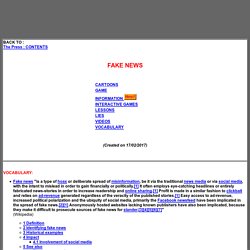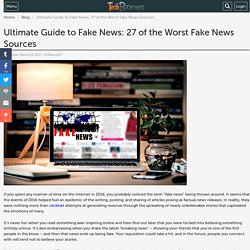

FAKE NEWS. Lesson 1 analyse de l'image. Problématique. What fake news is. Vocab image LIE. AI generated real fake video of Barack Obama (1) Script video 2mn21 deep fake news Obama and explanation. You Won’t Believe What Obama Says In This Video! .mp4. SCRIPT video 1mn12 you won't believe what obama says. FAKE NEWS. Schools, Universities Teach Students the Truth About Fake News - Text + Audio - 15 April 2017 "Education programs, from universities to secondary schools, are trying to train students to understand fake news and the difference between quality and poor journalism.

" (learningenglish.voanews.com) Facebook adding 'educational tool' to help users spot fake news - Article + Video - 6 April 2017 (money.cnn.com) Teach schoolchildren how to spot fake news, says OECD "Thinktank’s education lead raises concerns over social media ‘echo chamber’ and says ability to discern fact from fiction is vital. " E.S.C.A.P.E. Junk News. GRADE LEVEL: Middle and high school TIME: 30-60 minutes MATERIALS: E.S.C.A.P.E.

Junk News poster (download), E.S.C.A.P.E.: Six Key Concepts worksheets (download), a news story for students to evaluate, internet access. Vocabulary of Credibility Flashcards. News Literacy. The Honest Truth about Fake News … and How Not to Fall for It (with Lesson Plan) Did you hear that Pope Francis endorsed Donald Trump for president?

Or that Hillary Clinton sold weapons to ISIS? Crazy, right? And … 100 percent false. But if you were one of the millions of people drawn to a bogus headline in your Facebook feed — or other social media platform of choice — and found yourself reading an article on what seemed like a legitimate news site (something like, say, The Political Insider, which “reported” the Clinton-ISIS story), then why wouldn’t you believe it? I mean, people you supposedly trust shared it with you and it ranked high in the Google search. Welcome to the world of “fake news.” Digital deception It comes as little surprise that the web is chock full of commercial click-bait hoaxes: get-rich-quick schemes, free Caribbean cruises, erectile dysfunction treatments … you name it. But as it turns out, the internet is also teeming with bogus information sites that masquerade as real news. Lesson Plan: How to Spot Fake News.
The problem of fake news came to a dizzying head in 2016 when a man fired a shot in a family pizzeria as he “self-investigated” a false report of a child abuse ring led by top democrats.

A BuzzFeed report confirmed that fake news stories, such as the one that claimed Hillary Clinton sold arms to ISIS, were actually viewed more times than articles from established and legitimate news sources. Did fake news have an impact on the election? How do we address the problem from here? This lesson plan features a Channel One News report on the problem. Then, students analyze the problem and consider steps media outlets and individuals need to take to prevent the viral spread of propaganda. GO TenQuestionsForFakeNewsFINAL. 'critical thinking sheet. Factitious. Video and a related lesson plan from TEDEd. Update: Please also see our new, 2017 lesson, Evaluating Sources in a ‘Post-Truth’ World: Ideas for Teaching and Learning About Fake News _________ How do you know if something you read is true? Why should you care?
We pose these questions this week in honor of News Engagement Day on Oct. 6, and try to answer them with resources from The Times as well as from Edutopia, the Center for News Literacy, TEDEd and the NewseumEd. Although we doubt we need to convince teachers that this skill is important, we like the way Peter Adams from the News Literacy Project frames it in a post for Edutopia. As he points out, every teacher is familiar with “digital natives” and the way they seem to have been born with the ability to use technology. Below, a roundup of tools, questions, activities and case studies we hope can help reduce this digital naïveté. How Media Literacy Can Help Students Discern Fake News. Ultimate Guide to Fake News: 27 of the Worst Fake News Sources.
If you spent any manner of time on the Internet in 2016, you probably noticed the term “fake news” being thrown around.

It seems that the events of 2016 helped fuel an epidemic of the writing, posting, and sharing of articles posing as factual news releases. In reality, they were nothing more than clickbait attempts at generating revenue through the spreading of nearly unbelievable stories that captivated the emotions of many. It’s never fun when you read something awe-inspiring online and then find out later that you were tricked into believing something entirely untrue.
It’s also embarrassing when you share the latest "breaking news" – showing your friends that you're one of the first people in the know – and then that news ends up being fake. Your reputation could take a hit, and in the future, people you connect with will tend not to believe your stories. Critical thinking is a key skill in media and information literacy, and the mission of libraries is to educate and advocate its importance. Discussions about fake news has led to a new focus on media literacy more broadly, and the role of libraries and other education institutions in providing this. When Oxford Dictionaries announced post-truth was Word of the Year 2016, we as librarians realise action is needed to educate and advocate for critical thinking – a crucial skill when navigating the information society. IFLA has made this infographic with eight simple steps (based on FactCheck.org’s 2016 article How to Spot Fake News) to discover the verifiability of a given news-piece in front of you.
Download, print, translate, and share – at home, at your library, in your local community, and on social media networks. The more we crowdsource our wisdom, the wiser the world becomes. Download the infographic Translations. Evaluating Sources in a ‘Post-Truth’ World: Ideas for Teaching and Learning About Fake News - The New York Times.
Back in 2015, when we published our lesson plan Fake News vs. Real News: Determining the Reliability of Sources, we had no way of knowing that, a year later, the Oxford Dictionaries would declare “post-truth” the 2016 word of the year; that fake news would play a role in the 2016 presidential election; that it would cause real violence; and that the president-elect of the United States would use the term to condemn mainstream media outlets he opposes.
Back then, to convince teachers that the skill was important, we quoted Peter Adams of the News Literacy Project on the “digital naïveté” of the “digital natives” we teach. Now, however, we doubt that we need to convince anyone. Fake news. How to Spot Fake News - FactCheck.org. Fake news is nothing new.

But bogus stories can reach more people more quickly via social media than what good old-fashioned viral emails could accomplish in years past. Concern about the phenomenon led Facebook and Google to announce that they’ll crack down on fake news sites, restricting their ability to garner ad revenue. Perhaps that could dissipate the amount of malarkey online, though news consumers themselves are the best defense against the spread of misinformation. Not all of the misinformation being passed along online is complete fiction, though some of it is. Snopes.com has been exposing false viral claims since the mid 1990s, whether that’s fabricated messages, distortions containing bits of truth and everything in between.
A lot of these viral claims aren’t “news” at all, but fiction, satire and efforts to fool readers into thinking they’re for real. In 2008, we tried to get readers to rid their inboxes of this kind of garbage.